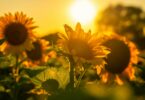Native wildflowers bring more than just beauty, they are essential for supporting local ecosystems and creating a natural haven for wildlife. Growing them is not only rewarding but also an easy way to give back to nature.
By planting native wildflowers, you help preserve the delicate balance of your local environment. They attract pollinators like bees, butterflies, and birds, improve soil health, and require less water and maintenance than non-native plants.
Let’s explore how you can successfully grow and care for native wildflowers in your own garden.
1. Choosing the Right Native Wildflowers

Not all wildflowers are the same, and selecting species that are native to your region increases the chances of a thriving, low-maintenance garden. Native plants have adapted to your local climate and soil, making them more resilient to drought, pests, and diseases.
Here are some popular native wildflowers to consider based on your region:
- Black-Eyed Susan (Rudbeckia hirta) – Bright yellow petals and dark centers attract pollinators.
- Purple Coneflower (Echinacea purpurea) – Loved by butterflies and bees for its vibrant purple petals.
- Milkweed (Asclepias spp.) – Essential for monarch butterflies’ survival.
- California Poppy (Eschscholzia californica) – Thrives in dry conditions and blooms in vibrant orange hues.
Tip: Research your local wildflower varieties through a resource like National Wildlife Federation to find species suited to your area.
2. Preparing Your Garden for Wildflowers
Successful wildflower growth starts with proper preparation. Follow these steps to create the ideal environment:
✅ Pick the Right Spot: Most wildflowers thrive in full sunlight (at least 6 hours daily).
✅ Test Your Soil: Wildflowers prefer well-drained soil. Use a soil test kit to check pH and nutrient levels.
✅ Clear the Area: Remove weeds, grass, and debris to give wildflowers space to grow.
✅ Loosen the Soil: Till the soil gently to about 2 inches deep to help the seeds establish roots.
3. Planting Native Wildflowers
The best time to plant native wildflowers is in early spring or fall when the soil is cool and moist.
Steps to Plant:
- Mix the wildflower seeds with sand to help distribute them evenly.
- Scatter the seeds over the prepared soil.
- Lightly press the seeds into the soil, but don’t bury them too deep—most wildflower seeds need sunlight to germinate.
- Water gently to keep the soil moist but not soggy.
Tip: Avoid using chemical fertilizers or pesticides, as they can harm pollinators and native plants.
4. Caring for Your Wildflowers
Once your wildflowers start to grow, maintaining them is easy:
✅ Watering: Water young seedlings regularly until they are established. Afterward, native wildflowers are drought-tolerant and require minimal watering.
✅ Weeding: Hand-pull weeds to prevent competition for nutrients and space.
✅ Pruning: Deadhead flowers (removing spent blooms) to encourage new growth and extend the blooming period.
✅ Natural Pest Control: Encourage natural predators like ladybugs and birds to manage pests.
5. Supporting Local Wildlife with Your Wildflower Garden
A native wildflower garden is more than just visually appealing—it’s a sanctuary for wildlife.
- Pollinators: Bees, butterflies, and hummingbirds are drawn to the vibrant colors and nectar.
- Birds: Seed-producing wildflowers provide food for birds in the fall and winter.
- Beneficial Insects: Ladybugs, lacewings, and beetles help control garden pests naturally.
Learn more about the importance of pollinators and how they impact ecosystems.
6. Troubleshooting Common Wildflower Issues
Even native wildflowers can encounter challenges. Here’s how to handle common problems:
✅ Sparse Growth: Check soil quality and ensure proper sunlight exposure.
✅ Pest Damage: Encourage natural predators and avoid chemical pesticides.
✅ Overcrowding: Thin out seedlings to give each plant enough space to grow.
✅ Poor Blooming: Ensure the plants are receiving adequate sunlight and water
Growing native wildflowers is a rewarding way to create a vibrant, eco-friendly garden while supporting local wildlife. With the right preparation and care, you’ll enjoy a beautiful, low-maintenance display of color and life. Plus, knowing you’re helping the environment makes it even more rewarding.







